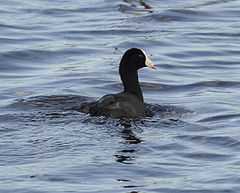Caribbean Coot
| Caribbean Coot | |
|---|---|
 | |
| Conservation status | |
| Scientific classification | |
| Kingdom: | Animalia |
| Phylum: | Chordata |
| Class: | Aves |
| Order: | Gruiformes |
| Family: | Rallidae |
| Genus: | Fulica |
| Species: | F. caribaea |
| Binomial name | |
| Fulica caribaea Ridgway, 1884 | |
The Caribbean Coot (Fulica caribaea) is a large waterbird of the family Rallidae, which is a resident breeder in the Caribbean and parts of Venezuela. Several alleged sightings have occurred in North America, but these cannot be authenticated since some American Coots (Fulica americana) lack red knobs on the frontal shield of the bill. The Caribbean Coot has sometimes been treated as a subspecies of the latter species.
The adult is 33–38 centimetres (13–15 in) long and has a short thick white bill with a reddish-brown spot near the tip and a white forehead shield. The body is grey with the head and neck darker than the rest of the body. The legs are yellow, with scalloped toes rather than webbed feet. It differs from the American Coot in that the latter species usually has red knobs at the top of its frontal shield.
The breeding habitat is freshwater lakes and marshes. They build a nest in shallow water or floating, and lay 4-8 speckled whitish or pale brown eggs. They are frequently seen swimming in open water.
Caribbean Coots can dive for food but can also forage on land. They are omnivores, eating plant material, insects, fish, and other aquatic animals.
Their call is a high-pitched squeaking honk somewhat like a goose, similar to American Coot.
References
- ↑ BirdLife International (2012). "Fulica caribaea". IUCN Red List of Threatened Species. Version 2013.2. International Union for Conservation of Nature. Retrieved 26 November 2013.
- Birds of Venezuela by Hilty, ISBN 0-7136-6418-5
- Rails by Taylor and van Perlo, ISBN 90-74345-20-4
